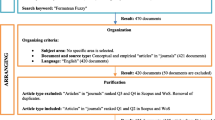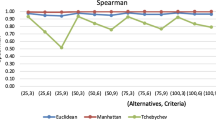Abstract
The mathematical representation of human preferences has been a subject of study for researchers in different fields. In multi-criteria decision making (MCDM) and fuzzy modeling, preference models are typically constructed by interacting with the human decision maker (DM). However, it is known that a DM often has difficulties to specify precise values for certain parameters of the model. He/she instead feels more comfortable to give holistic judgements for some of the alternatives. Inference and elicitation procedures then assist the DM to find a satisfactory model and to assess unjudged alternatives. In a related but more statistical way, machine learning algorithms can also infer preference models with similar setups and purposes, but here less interaction with the DM is required/allowed. In this article we discuss the main differences between both types of inference and, in particular, we present a hybrid approach that combines the best of both worlds. This approach consists of a very general kernel-based framework for constructing and inferring preference models. Additive models, for which interpretability is preserved, and utility models can be considered as special cases. Besides generality, important benefits of this approach are its robustness to noise and good scalability. We show in detail how this framework can be utilized to aggregate single-criterion outranking relations, resulting in a flexible class of preference models for which domain knowledge can be specified by a DM.
Similar content being viewed by others
References
Agresti A (2002) Categorical data analysis, 2nd version. Wiley, New York
Bishop C (2006) Pattern recognition and machine learning. Springer, Berlin
Boutilier C, Brafman R, Domshlak C, Hoos H, Poole D (2004) Cp-nets: a tool for representing and reasoning with conditional ceteris paribus preference statements. J Artif Intell Res 21: 135–191
Bouyssou D, Marchant T, Pirlot M, Tsoukias A, Vincke P (2006) Evaluation and decision models with multiple criteria. Springer, Berlin
Bradley R, Terry M (1952) Rank analysis of incomplete block designs. I: The method of paired comparisons. Biometrika 39: 324–345
Chu W, Ghahramani Z (2005) Gaussian processes for ordinal regression. J Mach Learn Res 6: 1019–1041
Chu W, Keerthi S (2005) New approaches to support vector ordinal regression. In: Proceedings of the International Conference on Machine Learning, Bonn, Germany, pp 321–328
Crammer K, Singer Y (2001) Pranking with ranking. In: Proceedings of the Conference on Neural Information Processing Systems, Vancouver, Canada, pp 641–647
Cristianini N, Shawe-Taylor J (2000) An introduction to support vector machines. Cambridge University Press, Cambridge
De Baets B, De Meyer H (2005) Transitivity frameworks for reciprocal relations: cycle-transitivity versus FG-transitivity. Fuzzy Sets Syst 152: 249–270
De Baets B, Fodor J (2003) Additive fuzzy preference structures, the next generation. In: De Baets B, Fodor J (eds) Principles of Fuzzy Preference Modelling and Decision Making. Academia Press, New York, pp 15–27
De Baets B, Van De Walle B, Kerre E (1995) Fuzzy preference structures without incomparability. Fuzzy Sets Syst 76: 333–348
Dias L, Mousseau V (2006) Inferring ELECTRE’s veto-related parameters from outranking examples. Eur J Oper Res 170: 172–191
Doumpos M, Zopounidis C (2004) A multicriteria classification approach based on pairwise comparisons. Eur J Oper Res 158: 378–389
Doyle J (2004) Prospects for preferences. Comput Intell 20: 111–136
Fan Z, Ma J, Zhang Q (2002) An approach to multiple-attribute decision making based on fuzzy preference information on alternatives. Fuzzy Sets Syst 131: 101–106
Freund Y, Yier R, Schapire R, Singer Y (2003) An efficient boosting algorithm for combining preferences. J Mach Learn Res 4: 933–969
Fürnkranz J, Hüllermeier E (2003) Pairwise preference learning and ranking. Lect Notes Comput Sci 2837: 145–156
Gheorghe R, Bufardi A, Xirouchakis P (2004) Construction of two-parameters fuzzy outranking relations from fuzzy evaluations. Fuzzy Sets Syst 143: 391–412
Gheorghe R, Bufardi A, Xirouchakis P (2005) Construction of global fuzzy preference structures from two-parameter single-criterion fuzzy outranking relations. Fuzzy Sets Syst 153: 303–330
Gonzales C, Perny P (2004) GAI networks for utility elicitation. In: Proceedings of the 9th International Conference on the Principles of Knowledge Representation and Reasoning, pp 224–234
Grabisch M, Kojadinovic I, Meyer P (2008) A review of methods for capacity identification in Choquet integral based multi-attribute utility theory, applications of the kappalab R package. Eur J Oper Res 186: 766–785
Greco S, Mousseau V, Slowinski R (2008) Ordinal regression revisited: multiple criteria ranking using a set of additive value functions. Eur J Oper Res 191: 415–435
Hastie T, Tibshirani R, Friedman J (2001) The elements of statistical learning. Springer, Berlin
Herbrich R, Graepel T, Obermayer K (2000) Large margin rank boundaries for ordinal regression. In: Smola A, Bartlett P, Scholkopf B, Schuurmans D (eds) Advances in Large Margin Classifiers. MIT Press, Cambridge, pp 115–132
Herbrich R, Minka T, Graepel T (2007) Trueskill: a bayesian skill rating system. In: Schölkopf B, Platt J, Hoffman T (eds) Advances in Neural Information Processing Systems. MIT Press, Cambridge, vol 19, pp 569–576
Jung S, Hong JH, Kim T-S (2005) A statistical model for user preference. IEEE Trans Knowl Data Eng 17: 834–843
Kojadinovic I (2004) Estimation of the weights of interacting criteria from the set of profiles by means of information-theoretic functionals. Eur J Oper Res 155: 741–751
Lievens S, De Baets B, Cao-Van K (2008) A probabilistic framework for the design of instance-based supervised ranking algorithms in an ordinal setting. Ann Oper Res 163: 115–142
Marichal JL, Meyer P, Roubens M (2005) Sorting multi-attribute alternatives: The TOMASO method. Comput Oper Res 32: 861–877
Mousseau V (2005) A general framework for constructive learning preference elicitation in multiple criteria decision aid. Technical report, LAMSADE, Université Paris-Dauphine, France
Mousseau V, Slowinski R (1998) Inferring an ELECTRE TRI model from assignment examples. J Global Optim 12: 157–174
Mousseau V, Figueira J, Naux J (2001) Using assignment examples to infer weights for ELECTRE TRI method: Some experimental results. Eur J Oper Res 130(2): 263–275
Mousseau V, Dias L, Figueira J (2006) Dealing with inconsistent judgments in multiple criteria sorting. 4OR 4: 145–158
Öztürk M, Tsoukiàs A, Vincke Ph (2005) Preference modelling. In: Figueira J, Greco S, Ehrgott M (eds) Multiple Criteria Decision Analysis. State of the art surveys. Springer, Berlin, pp 27–71
Perny P (1992) Modelisation, Agrégation et Exploitation de Préférences Floues dans une Problématique de Rangement. Ph.D. thesis, Université Paris-Dauphine
Radlinski F, Joachims T (2007) Active exploration for learning rankings from clickthrough data. In: Proceedings of the International Conference on Knowledge Discovery and Data Mining, San Jose, CA, USA, pp 570–579
Rennie JD, Srebro N (2005) Loss functions for preference levels: Regression with discrete, ordered labels. In: Proceedings of the IJCAI Multidisciplinary Workshop on Advances in Preference Handling, Edinburgh, Scotland, pp 180–186
Roy B (1991) The outranking approach and the foundations of ELECTRE methods. Theory Decision 31(1): 49–73
Schölkopf B, Smola A (2002) Learning with Kernels, support vector machines, regularisation, optimization and beyond. MIT Press, Cambridge
Shashua A, Levin A (2003) Ranking with large margin principle: Two approaches. In: Proceedings of the International Conference on Neural Information Processing Systems, Vancouver, Canada. MIT Press, Cambridge, pp 937–944
Shawe-Taylor J, Cristianini N (2004) Kernel methods for pattern analysis. Cambridge University Press, Cambridge
Switalski Z (2003) General transitivity conditions for fuzzy reciprocal preference matrices. Fuzzy Sets Syst 137: 85–100
Thurstone L (1927) A law of comparative judgment. Psychol Rev 79: 281–299
Van De Walle B, De Baets B, Kerre E (1998) Characterizable fuzzy preference structures. Ann Oper Res 80: 105–136
Vincke Ph (1992) Multicriteria decision-aid. Wiley, New York
Waegeman W, De Baets B, Boullart L (2008a) ROC analysis in ordinal regression learning. Pattern Recognit Lett 29: 1–9
Waegeman W, De Baets B, Boullart L (2008b) On the scalability of ordered multi-class ROC analysis. Comput Stat Data Anal 52: 3371–3388
Wang Y-M, Parkan C (2005) Multiple attribute decision making based on fuzzy preference information on alternatives: Ranking and weighting. Fuzzy Sets Syst 153: 331–346
Wu F, Lin C, Weng R (2004) Probability estimates for multi-class support vector machines by pairwise coupling. J Mach Learn Res 5: 975–1005
Author information
Authors and Affiliations
Corresponding author
Rights and permissions
About this article
Cite this article
Waegeman, W., De Baets, B. & Boullart, L. Kernel-based learning methods for preference aggregation. 4OR-Q J Oper Res 7, 169–189 (2009). https://doi.org/10.1007/s10288-008-0085-5
Received:
Revised:
Published:
Issue Date:
DOI: https://doi.org/10.1007/s10288-008-0085-5
Keywords
- Preference relations
- Kernel methods
- Aggregation of criteria
- Inference procedures
- Quadratic programming
- Preference learning




